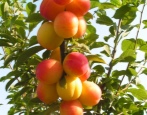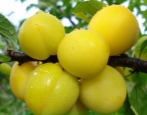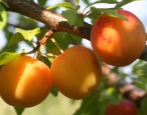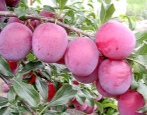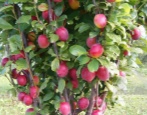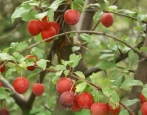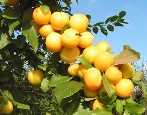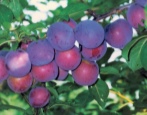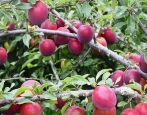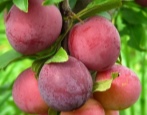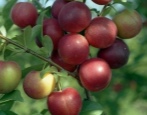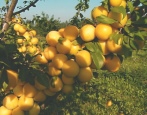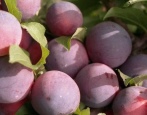
- Authors: V.A. Matveev, M.P. Malyukevich, Z.A. Kozlovskaya, M.G. Maksimenko (Belarusian Research Institute of Fruit Growing)
- Name synonyms: Prunus cerasifera Mara
- Year of approval: 2002
- Growth type: vigorous
- Ripening period: late
- Self-fertility: self-infertile
- Fruit size: average
- Yield: high
- Appointment: universal
- Fruit weight, g: 25
Cherry plum - this beautiful oriental word hides one of the types of home plum familiar to everyone from childhood. The homeland of this culture is hot Asia Minor and Transcaucasia, and its fruits, unlike ordinary plums, are not purple, but yellow.
This article will focus on the variety of cherry plum Mara, also known as "Russian plum".
Breeding history
The hybrid variety was bred by Belarusian breeders in the late 80s of the last century through free pollination of cherry plum and wild willow plum, also known as Chinese plum. In Russia, the Mara variety has been officially allowed to grow since 2002, as soon as the plant was entered in the State Register, and it has been included in the State Register of Belarus since 1999.
Description of the variety
The tree is tall, with a rounded, medium thickened crown. It grows quite quickly, already 5 years after planting, its height is about 3-4 meters. The bark is dark brown, on young branches it has a burgundy tint. The leaves are bright green, glossy, have the shape of an elongated oval with a sharp tip and jagged edges. The flowers of the Mara cherry plum are single, white and small, the flowering is lush and abundant - in the spring these trees will become a real decoration of the garden.
Fruit characteristics
The fruits are bright yellow, round, slightly flattened at the ends. The weight of one berry is 25 grams. The pulp is loose and juicy, protected by a dense skin. In the middle there is a medium-sized bone that has grown into the flesh, which makes it difficult to separate. The fruits do not deteriorate for a long time - at normal temperature cherry plum can be stored for a month.
Taste qualities
The taste of Mara cherry plum is sweet and sour and very pleasant, a bit like sour grape varieties. Professional tasters rate it at 4 points out of 5. The fruit can be eaten both fresh and as preserves, jams and various sauces.
Ripening and fruiting
Fruiting occurs in 2-3 years. Ripening occurs in late August - early September, depending on the growing region.
Yield
The Mara variety reaches its maximum fruiting rates starting from 6-7 years - then the yield from one tree is about 40 kg of drupe. With a large number of fruits, some of them are removed slightly unripe and left to ripen in a cool place.
Growing regions
The Mara variety is recommended for cultivation in the Central, North-West, Volgo-Vyatka regions. However, practice shows that the culture can be grown in almost any region of our country, except for the Far North. It has a high winter hardiness, which allows it to be planted even in areas where the temperature reaches -33 ... 35. Drought resistance is also quite good, but during long dry periods, trees need abundant watering.
Self-fertility and the need for pollinators
Cherry plum of the Mara variety, like most plums, is a self-fertile crop, that is, cross-pollination is necessary to obtain a crop. Therefore, it is recommended to plant Vitba cherry plum or an ordinary wild-growing plum next to Mara. Mara herself is also an effective pollinator for other species.
Growing and care
Cherry plum is a light-loving plant, therefore, these trees should be planted on the southern or southwestern side of the garden plot, fenced off from strong winds. The ideal option would be a place between two buildings.
The soil should be loose and saturated with nutrients, and the groundwater level should be located no closer than 1.5-2 meters to the surface of the earth.
It is recommended to purchase seedlings in special nurseries in order to eliminate the risk of buying low-quality garden material. Best of all, Mary's trees take root at the age of 2 years. You should buy only those seedlings that were grown in your area, otherwise there is a high risk that the tree will die.
Cherry plum is planted in spring to reduce the risk of plant roots freezing. In the southern regions, you can do this in the autumn.
The step-by-step landing scheme is quite traditional. The main thing is not to forget to install a peg in order to tie the young cherry plum plant, and leave the root collar of Mary at ground level.
When planting several trees of the variety, the distance between them should be 3-4 meters, so that in the future the crowns of adult plants do not interfere with each other.
Caring for Mara cherry plum is also traditional.
In late March - early April, it is necessary to dig small grooves in the ground so that the water from the melted snow does not stagnate in the area.
In April, dead parts of the bark are removed from the surface of the trunk of Mary and the trees are pruned, the soil is dug up, fertilized with nitrogen fertilizers, the cuttings are grafted and sanitary and preventive treatment against fungi and parasites is carried out.
In May, Mara cherry plum is fed with mineral fertilizers. In the summer, trees need to be watered regularly (1-2 times a month), and then loosened near the trunk circle and remove weeds.
If the harvest is expected to be plentiful, props must be installed in advance.
In September, when fruiting occurs and buds are laid for the next year, the care of Mara cherry plum should be especially careful and include feeding with organic or potassium-phosphorus fertilizers, loosening and weeding.
In autumn, after harvesting the fruits, the soil is dug up and saturated with mineral fertilizers. Before the leaves fall, the tree needs abundant watering.
In addition to a layer of mulch, the Mara variety does not need additional insulation, since it is frost-resistant, but if the region is very cold, then it is better to cover the young seedlings. To prepare the culture for winter, dead wood is cleaned, and the stem and base are whitewashed with slaked lime with the addition of copper sulfate. All hollows must be sealed, young root shoots must be cut out, fallen leaves must be removed with a rake and burned.
It should be borne in mind that the cherry plum of the Mara variety grows rapidly and requires more frequent pruning than other varieties. With correct and timely pruning, Mara bears fruit better and acquires immunity to disease.
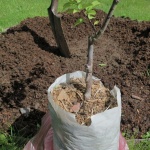
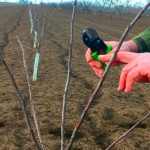
Disease and pest resistance
The Mara variety is extremely resistant to pests and fungal diseases, including clotterosporia, but preventive measures are never superfluous. As a protection, trees should be regularly sprayed with insecticides and fungicides.

Requirements for soil and climatic conditions
For growing this cherry plum, neutral or slightly acidic soil is most preferable. If the soil on the site is heavy and clayey, then a planting pit filled with a mixture of a suitable type of soil and fertilizers can help in this case.
As for the climate, the Mara variety generally tolerates low temperatures well, but in severe frosts it needs to be mulched with rotted manure.
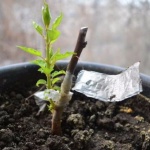
Review overview
Gardeners praise the Mara variety for its resistance to adverse conditions and the pleasant sour taste of the fruit. Users of culinary sites recommend preparing Georgian tkemali sauce, jam and compotes from this cherry plum. Of the shortcomings, many note the difficulty in separating the bone from the pulp, which is not always convenient.
Since the variety has a high yield, experienced gardeners are advised to take care of the branches and install supports in time so that the tree does not break under the weight of the fruit.

